Discover the wonders of Iceland’s summer and early fall treasures with these two epic 2-day road trips for nature enthusiasts. Get ready for a journey that will leave you in awe of Iceland’s untamed wilderness and breathtaking landscapes.
As usual with any road trip in Iceland, make sure you’re dressed appropriately and have adequate snacks, drinks and gasoline before you set off. Also check the weather forecast!
Two-Day Road Trip in the Vatnsnes Peninsula and Akureyri: Mythology and Wild Seals
Your two-day road trip exploring this fascinating region starts and ends in Hvammstangi, arguably one of the best places to learn all about wild seals.
Located in the northwest of Iceland, about a 3-hour drive north of the capital, Reykjavik, the Vatnsnes Peninsula – surrounded by the waters of Miðfjörður Fjord to the west and Húnafjörður Fjord to the northeast – is home to one of the largest seal colonies in Iceland.
DAY 1
Admire wild seals in their natural environment at Illugastaðir Farm
Before departing for Illugastaðir Farm to view the wild seals, it’s strongly suggested to visit the extremely informative Icelandic Seal Centre located in the pretty village harbor of Hvammstangi.
As you set off on your drive along the breathtaking Icelandic coastline, a visit to Illugastaðir Farm promises an unforgettable encounter with the charismatic inhabitants of the seas—the gray and harbor seals of Iceland. Nestled in the remote and untouched landscape, this rugged coast offers a rare opportunity to observe these charming creatures in their undisturbed natural habitat.
Arriving at the free parking area of Illugastaðir Farm, take the path that starts parallel to the sea. After a short 15–20 minute walk, you will reach a high point next to a small wooden lookout hut. If possible, bring a pair of binoculars as most of the time the seals will be lounging on distant rocks.
If you quietly approach the rocky shores, there’s a good chance you’ll be rewarded with the sight of seals playfully frolicking in the waves and basking under the soft Arctic sun. Their adorable antics, inquisitive eyes and graceful movements will leave you in awe of the wonders of Icelandic wildlife.
* The best time for spotting seals is two hours before and after low tide, so do plan your day accordingly using this excellent maritime chart. If the tides don’t work for this location, you can also check out Svalbarð and Hvítserkur for seal gazing.
Say hello to the Basalt Stone Troll, Hvítserkur
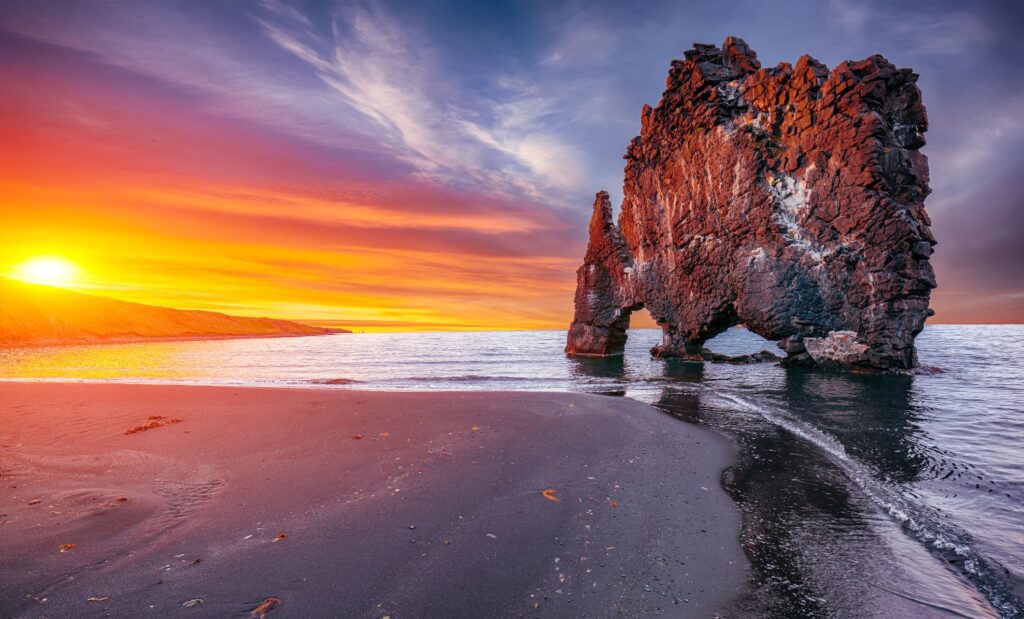
Jutting dramatically 15 meters out of the dark Icelandic waters like a mythical guardian, Hvítserkur is a fascinating basalt sea stack located on the eastern shore of the Vatnsnes Peninsula. Its unusual stony silhouette, often compared to a rhinoceros, a drinking elephant, a dragon or a dinosaur, was formed by the pounding of the mighty Atlantic Ocean.
Steeped in Icelandic folklore, this geological marvel is believed to be a former troll who was caught in the act of destroying a nearby church. Blinded by his anger, he failed to notice that the sun was slowly dawning over the horizon leaving him petrified for all eternity.
Whether you choose to admire the ancient stone giant of Hvítserkur from afar or venture closer during low tide, its imposing presence and eerie silhouette against the horizon make it one of Iceland’s most photographed landmarks.
Visit the mythical castle of Borgarvirki
Borgarvirki, often referred to as the “Castle of the Elves,” is a fascinating historical site located in northern Iceland, near the town of Varmahlíð. This natural fortress consists of a basalt fortress ridge, rising majestically from the surrounding lava fields, reminiscent of an ancient stone fortress perched atop a hill.
Its strategic location provided a vantage point for early settlers and Viking chieftains, making it an essential defensive position during Iceland’s early history.
As you climb to the top of this natural citadel, you’ll be rewarded with sweeping vistas of the vast lava plains and the river valleys winding their way through the rugged terrain. Standing amidst the ancient stones, it’s easy to imagine the stories of battles and mythical creatures that may have unfolded within these historical walls.
Overnight in Akureyri, the “Capital of the North”
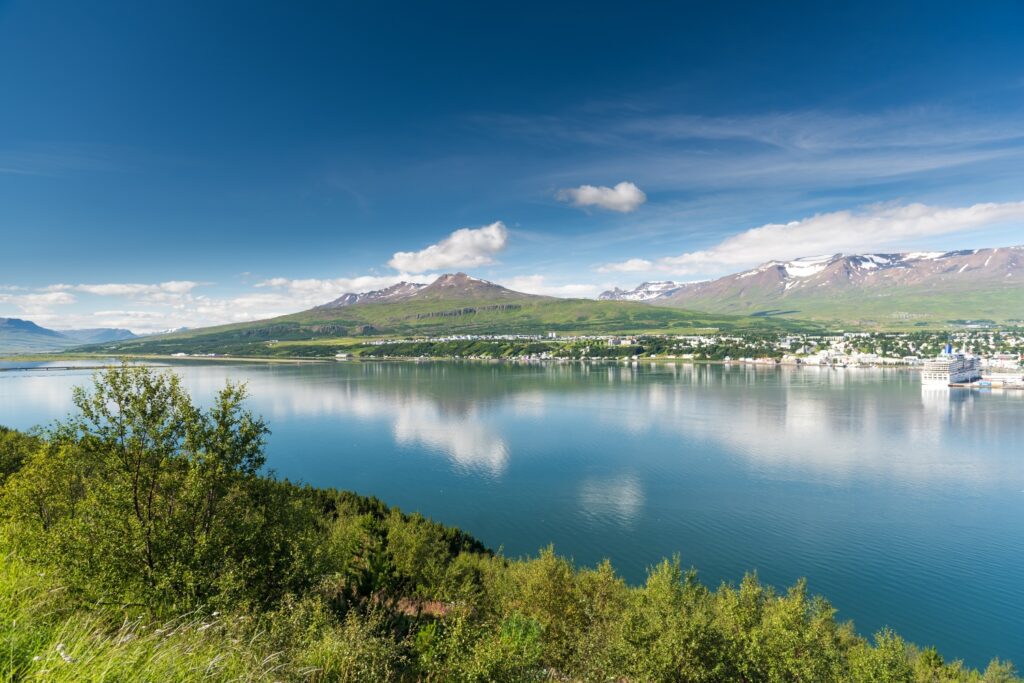
Akureyri, a vibrant and picturesque town, is the perfect place for spending some time exploring. Nestled along the shores of the Eyjafjörður Fjord, Iceland’s second largest city is surrounded by stunning mountain ranges, providing a breathtaking backdrop for this charming coastal community.
Akureyri offers an array of cultural and recreational activities, making it an alluring destination throughout the year. However, during the summer months, the town comes alive with festivals, concerts, and art exhibitions, providing a glimpse into Iceland’s vibrant arts and cultural scene. Get here early if you’d like to check out the summer vibes!
A wide range of accommodation is available to choose from for your overnight stay, from guesthouses and apartments to campsites, hostels, and hotels.
DAY TWO
Swim into infinity and beyond in Hofsós
After spending a leisurely morning in Akureyri, it’s time to hit the road again.
Hofsós, a delightful fishing village nestled along the Skagafjörður Fjord, offers visitors a serene and charming escape with breathtaking views of the sea and the towering Drangey Island in the distance.
One of the main highlights is undoubtedly the Hofsós Swimming Pool, an architectural gem that seems to merge with the surrounding landscape. Perched on a hilltop overlooking the fjord, the infinity pool provides an extraordinary experience, allowing visitors to relax in the warm waters while immersing themselves in the stunning panoramas that stretch as far as the eye can see.
Explore the scenic canyon of Kolugljúfur
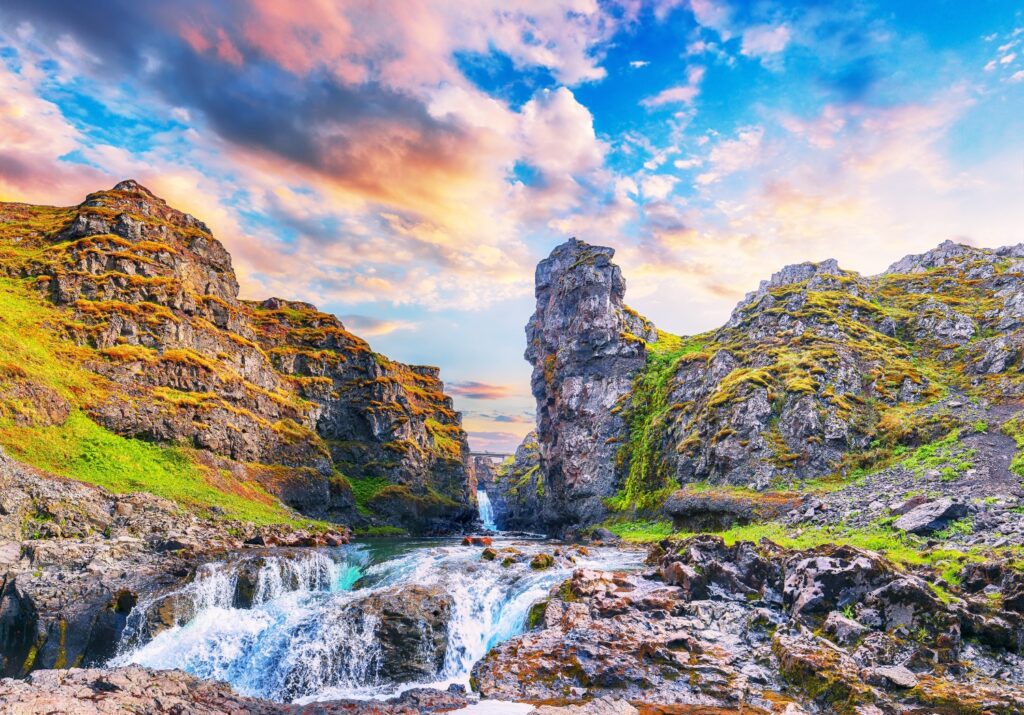
Kolugljúfur, a breathtaking canyon carved by the Kolugljúfur River over thousands of years, boasts towering basalt walls that reach heights of up to 40 meters (131 feet). The river cascades through the volcanic canyon, creating mesmerizing waterfalls and pools along its course, adding to the ethereal beauty of the landscape.
Kolugljúfur is named after the legendary giantess Kola, whose folklore tells tales of her strength and magical powers, making the canyon not only a geological marvel but also a place steeped in Icelandic myths.
Hiking along the canyon’s edge provides awe-inspiring views of the river’s tumultuous path below, as well as opportunities to spot local birdlife, such as Arctic terns and fulmars.
Return to your starting point in Hvammstangi and enjoy the rest of your day exploring this quaint village.
Two-Day Road Trip in the Gábrók Volcanic Craters and Reykjanes Peninsula
Your two-day road trip exploring these two regions starts and ends in Reykjavík.
DAY 1
Climb to the top of Grábrók crater
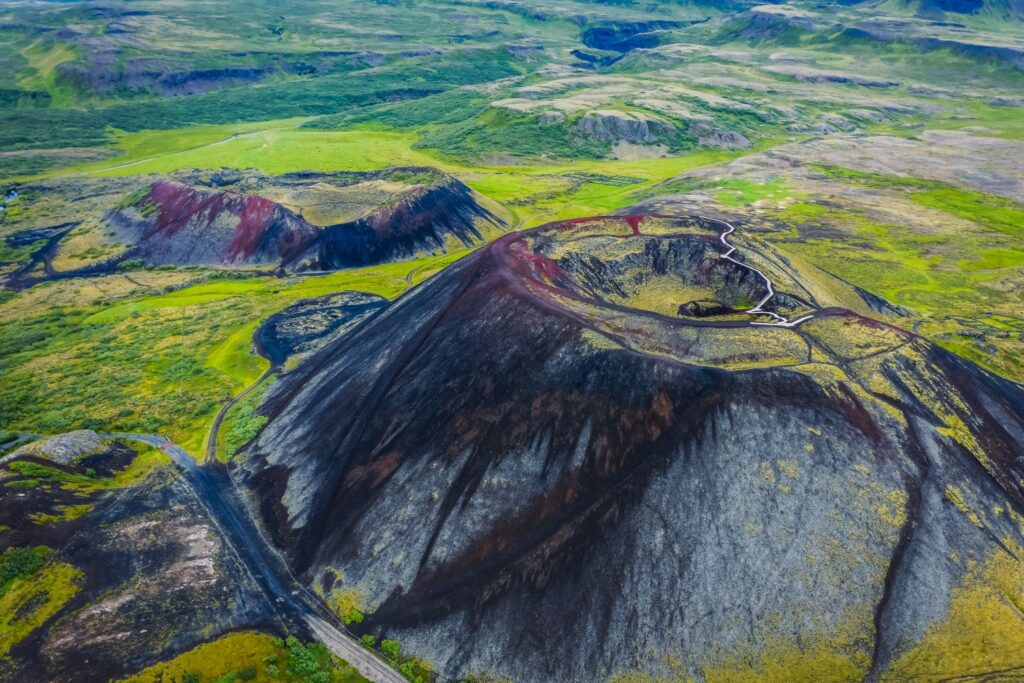
Get ready to lace up your hiking boots and set off to explore the Grábrók volcanic crater.
Nestled in the western region of Iceland, Grábrók is the largest of three craters within the same volcanic fissure, each with its own level of challenge and boasting panoramic views of the surrounding lava fields.
The well-marked trail leads you to the rim of the crater making this relatively short hike suitable for most fitness levels and an excellent opportunity to intimately experience Iceland’s volcanic landscapes.
As you summit the rocky slopes and stand at the crater’s edge, the sheer beauty and geological wonders of the region unfold before you, leaving an indelible impression of this captivating part of Iceland’s natural heritage.
Grábrók Volcano Information Center
Either before or after your hike, take time to visit the nearby Grábrók Volcano Information Center where you can learn about the volcanic history of the area, the formation of the crater, and the impact of volcanic activity on Iceland’s landscape and geology.
Soak it up at Deildartunguhver Hot Springs
About a 20-minute drive from Grábrók, you’ll find Deildartunguhver, a geothermal wonder and the most powerful hot spring in all of Europe. This incredible natural marvel boasts an impressive flow rate, producing over 180 liters of boiling water per second. The water emerges from the ground at a scorching temperature of approximately 97 degrees Celsius (207 degrees Fahrenheit), making it an essential resource for heating homes and greenhouses in nearby towns and villages.
As you approach Deildartunguhver, you’ll be met with a mesmerizing display of steam rising from the bubbling waters, creating an ethereal atmosphere around the hot spring area. The hot springs’ immense power and significance as a geothermal energy source underscore Iceland’s reliance on its abundant natural resources to harness energy sustainably and provide a unique glimpse into the country’s geological wonders.
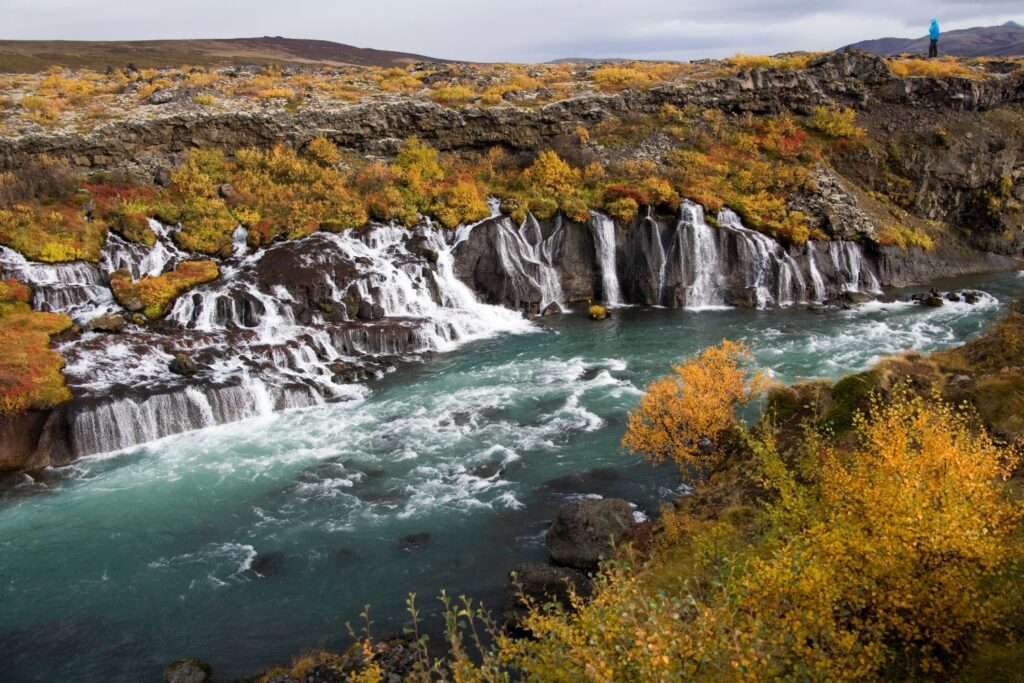
*If you have time and wish to explore further today, you can drive to Hraunfossar and Barnafoss Waterfalls. They are a bit further from Grábrók, but still within a reasonable distance. Hraunfossar, or “Lava Falls,” is a series of waterfalls that emerge from the edge of a lava field, creating a stunning display of water cascading over the lava formations. Barnafoss, or “Children’s Falls,” offers an interesting folklore tale and another beautiful waterfall to admire.
Discover Viking history with an overnight stay in Borgarnes
Borgarfjörður, a picturesque fjord located in the western part of Iceland, is known for its captivating landscapes and rich history. As you venture along the shores of Borgarfjörður, you’ll be treated to breathtaking views of towering mountains, lush valleys, and charming coastal villages.
The fjord’s serene beauty offers a peaceful escape and is the perfect place for an overnight stay in the historic town of Borgarnes, where you can delve into the region’s Viking heritage and learn about Iceland’s medieval sagas.
A wide range of accommodation is available to choose from for your overnight stay, from guesthouses and hotels to campsites and cottages.
DAY TWO
After your overnight stay in Borgarnes, it’s time to explore the Reykjanes Peninsula.
Witness an active eruption at Fagradalsfjall Volcano
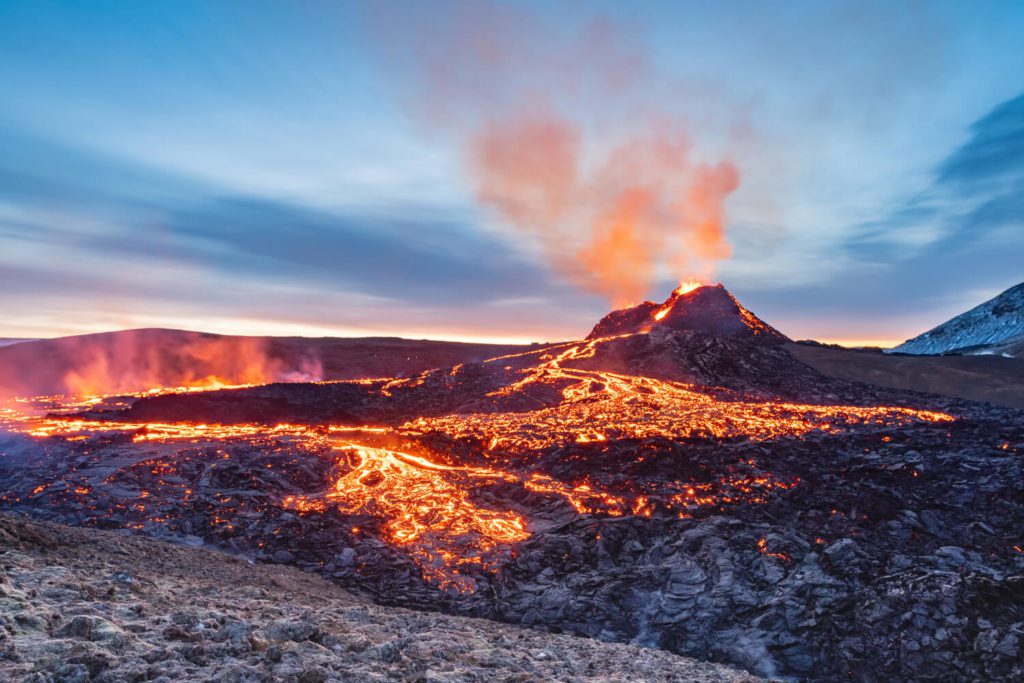
The Reykjanes Peninsula is located in an area where two very active tectonic plates collide, generating a wild and impressive nature. After the 2021 and 2022 eruptions in Fagradalsfjall, scientific experts predicted this peninsula would become one of the most dynamic volcanic areas on the planet for several generations.
That proved to be true with the most recent eruption on July 10, 2023, when a fissure eruption started on the Reykjanes Peninsula northwest of the previous sites. While the new site is only 38 kilometers (24 miles) from Reykjavík, it does not pose any immediate danger and can be visited with adequate precautions.
Get steamy at Gunnuhver Hot Springs
Named after a vengeful ghost from Icelandic folklore, Gunnuhver’s geothermal bubbling mud pools and steaming sulfur vapor fumaroles create an otherworldly and mysterious atmosphere.
As powerful and forceful bursts of steam rise dramatically from the earth’s depths, there’s no doubt these hot springs are one of the most active geothermal areas in Iceland, boasting temperatures that can reach up to 300 degrees Celsius (572 degrees Fahrenheit).
Hike the cliffs of Valahnúkamöl
Valahnúkamöl, also known as Reykjanestá, is the most south-western tip of the Reykjanes Peninsula and considered one of the most scenic landscapes in the area.
Towering and dramatic sea cliffs, sculpted by the relentless force of the North Atlantic Ocean, stretch as far as the eye can see, creating a panorama of striking rock formations, columnar basalt pillars, and sea stacks rising majestically from the crashing waves below.
As you hike along the rugged trails of these precipitous cliffs, you’ll be treated to awe-inspiring views of the vast ocean stretching to the horizon. The interplay of light and shadow on the dark volcanic rock creates a mesmerizing scene, especially during sunrise and sunset, when the cliffs are bathed in golden hues.
End the day at Reykjanesviti lighthouse
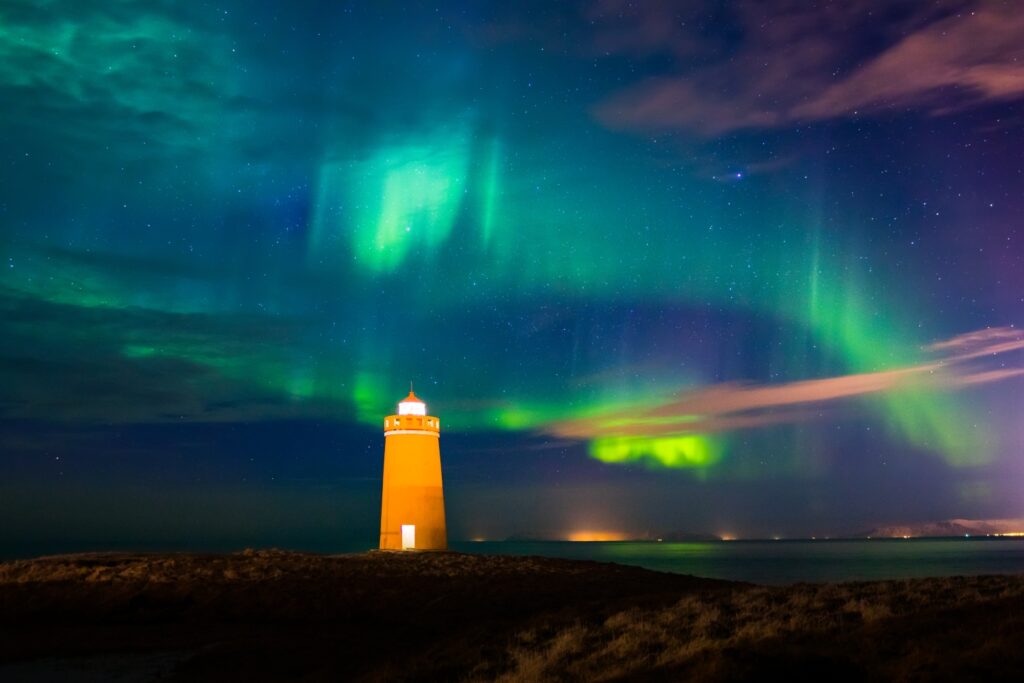
Reykjanesviti lighthouse, a stoic beacon on the dramatic Reykjanes Peninsula, marks the southwesternmost point of Iceland. This iconic lighthouse is not only a functional navigational aid for mariners but also a symbol of Iceland’s rich maritime history and the indomitable spirit of its people.
The striking red-and-white tower, with its commanding views of the surrounding volcanic landscapes and the boundless North Atlantic Ocean, offers a picturesque sight for visitors and makes a fitting place for a perfect end to this road trip.
Return to Reykjavík for your overnight stay, selecting from a range of accommodation to suit all tastes and budgets.
If you feel in need of relaxing and refreshing after your self-drive road trip, why not try out a centuries-old cultural tradition and visit one of Iceland’s natural spa resorts. The perfect way to unwind after a few days behind the wheel.
For more road trips in Iceland, check out our tips for driving the Golden Circle.
And if you’re looking for inspiration for other things to try out during your visit to Iceland, check out the rest of our blog, filled with ideas and top tips on getting the most out of your Icelandic adventure.
Back